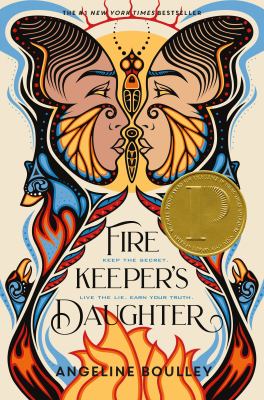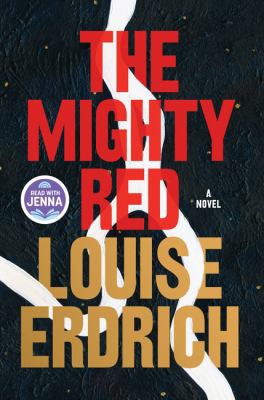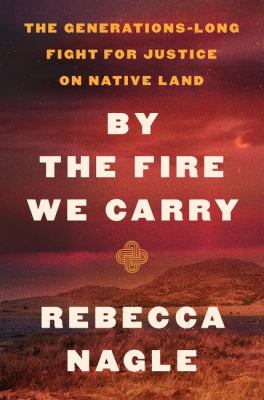
Firekeeper’s Daughter
by Angeline Boulley
“Daunis, who is part Ojibwe, defers attending the University of Michigan to care for her mother and reluctantly becomes involved in the investigation of a series of drug-related deaths.”
Firekeeper’s Daughter #1

The Mighty Red: A Novel
by Louise Erdrich
“In this stunning novel, Pulitzer Prize and National Book Award-winning author Louise Erdrich tells a story of love, natural forces and the tragic impact of big business.” — Provided by publisher

Keepunumuk : Weeâchumun’s Thanksgiving Story
by Danielle Greendeer, Anthony Perry, & Alexis Bunten
“Wampanoag children listen as their grandmother tells them the story about how Weeâchumun (the wise Corn) asked local Native Americans to show the Pilgrims how to grow food to yield a good harvest–Keepunumuk–in 1621.”

Girl Warrior: On Coming of Age
by Joy Harjo
“Informed by her own experiences and those of her ancestors, Harjo offers inspiration and insight for navigating the many challenges of maturation. She grapples with parents, friendships, love, and loss. She guides young readers toward painting, poetry, and music as powerful tools for developing their own ethical sensibility. As Harjo demonstrates, the act of making is an essential part of who we are,a means of inviting the past into the present and a critical tool young women can use to shape a more just future. Lyrical and compassionate, Harjo’s call for creativity and empathy is an urgent and necessary work.” –Provided by publisher.

The Serviceberry: Abundance and Reciprocity in the Natural World
by Robin Wall Kimmerer
“A bold and inspiring vision for how to orient our lives around gratitude, reciprocity, and community, based on the lessons of the natural world.” –Provided by publisher.

My Powerful Hair
by Carole Lindstrom
“Our ancestors say our hair is our memories, our source of strength and power, a celebration of our lives. Mom never had long hair–she was told it was too wild. Nokomis couldn’t have long hair–hers was taken from her. But one young girl can’t wait to grow her hair long: for herself, for her family, for her connection to her culture and the earth, and to honor the strength and resilience of those who came before her.”

By the Fire We Carry: The Generations-Long Fight for Justice on Native Land
by Rebecca Nagle
“A powerful work of reportage and American history in the vein of Caste and How the Word Is Passed that braids the story of the forced removal of Native Americans onto treaty lands in the nation’s earliest days, and a small-town murder in the ’90s that led to a Supreme Court ruling reaffirming Native rights to that land over a century later.” — Provided by publisher.

There There: A Novel
by Tommy Orange
“Not since Sherman Alexie’s The Lone Ranger and Tonto Fistfight in Heaven and Louise Erdrich’s Love Medicine has such a powerful and urgent Native American voice exploded onto the landscape of contemporary fiction. Tommy Orange’s There There introduces a brilliant new author at the start of a major career. “We all came to the powwow for different reasons. The messy, dangling threads of our lives got pulled into a braid–tied to the back of everything we’d been doing all along to get us here. There will be death and playing dead, there will be screams and unbearable silences, forever-silences, and a kind of time-travel, at the moment the gunshots start, when we look around and see ourselves as we are, in our regalia, and something in our blood will recoil then boil hot enough to burn through time and place and memory. We’ll go back to where we came from, when we were people running from bullets at the end of that old world. The tragedy of it all will be unspeakable, that we’ve been fighting for decades to be recognized as a present-tense people, modern and relevant, only to die in the grass wearing feathers.” Jacquie Red Feather is newly sober and trying to make it back to the family she left behind in shame in Oakland. Dene Oxedrene is pulling his life together after his uncle’s death and has come to work the powwow and to honor his uncle’s memory. Edwin Frank has come to find his true father. Bobby Big Medicine has come to drum the Grand Entry. Opal Viola Victoria Bear Shield has come to watch her nephew Orvil Red Feather; Orvil has taught himself Indian dance through YouTube videos, and he has come to the Big Oakland Powwow to dance in public for the very first time. Tony Loneman is a young Native American boy whose future seems destined to be as bleak as his past, and he has come to the Powwow with darker intentions–intentions that will destroy the lives of everyone in his path. Fierce, angry, funny, groundbreaking–Tommy Orange’s first novel is a wondrous and shattering portrait of an America few of us have ever seen. There There is a multi-generational, relentlessly paced story about violence and recovery, hope and loss, identity and power, dislocation and communion, and the beauty and despair woven into the history of a nation and its people. A glorious, unforgettable debut.” — Provided by publisher.

Medicine River: A Story of Survival and the Legacy of Indian Boarding Schools
by Mary Annette Pember
“A sweeping and trenchant exploration of the history of Native American boarding schools in the U.S., and the legacy of abuse wrought by systemic attempts to use education as a tool through which to destroy Native culture. From the mid-19th century to the late 1930s, tens of thousands of Native children were pulled from their families to attend boarding schools that claimed to help create opportunity for these children to pursue professions outside their communities and otherwise “assimilate” into American life. In reality, these boarding schools—sponsored by the US Government but often run by various religious orders with little to no regulation—were an insidious attempt to destroy tribes, break up families, and stamp out the traditions of generations of Native people. Children were beaten for speaking their native languages, forced to complete menial tasks in terrible conditions, sometimes starved or raped, and utterly deprived of love and affection. Ojibwe journalist Mary Pember’s mother was forced to attend one of these institutions—a seminary in Wisconsin, and the impacts of her experience have cast a pall over Mary’s own childhood, and her relationship with her mother. Highlighting both her mother’s experience and the experiences of countless other students at such schools, their families, and their children, Medicine River paints a stark portrait of communities still reckoning with the legacy of acculturation that has affected generations of Native communities. Through searing interviews and assiduous historical reporting, Pember traces the evolution and continued rebirth of a culture whose country has been seemingly intent upon destroying it.” -Goodreads

Love After the End: An Anthology of Two-Spirit & Indigiqueer Speculative Fiction
by Joshua Whitehead (Editor)
“A bold and breathtaking anthology of queer Indigenous speculative fiction, edited by the author of Jonny Appleseed. This exciting and groundbreaking fiction anthology showcases a number of new and emerging 2SQ (Two-Spirit and queer) Indigenous writers from across Turtle Island. These visionary authors show how queer Indigenous communities can bloom and thrive through utopian narratives that detail the vivacity and strength of 2SQness throughout its plight in the maw of settler colonialism’s histories. Here, readers will discover bioengineered AI rats, transplanted trees in space, the rise of a 2SQ resistance camp, a primer on how to survive Indigiqueerly, virtual reality applications, mother ships at sea, and the very bending of space-time continuums queered through NDN time. Love after the End demonstrates the imaginatively queer Two-Spirit futurisms we have all been dreaming of since 1492. Contributors include Nathan Adler, Darcie Little Badger, Gabriel Castilloux Calderón, Adam Garnet Jones, Mari Kurisato, Kai Minosh Pyle, David Alexander Robertson, jaye simpson, and Nazbah Tom.”– Provided by publisher.
